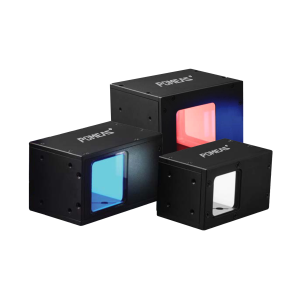As a kind of machine vision light source, coaxial light source has many remarkable features, which make it widely used in many inspection scenarios. The following is an example of a POMEAS coaxial light source to illustrate its features in detail:


Uniform Illumination: The coaxial light source provides more uniform illumination than traditional light sources. This is due to its special optical design, such as a high-density arrangement of LEDs and a unique heat dissipation structure, which enables the light to be uniformly illuminated on the surface of the object to be measured, avoiding any light spots or shadows that may be generated by conventional light sources, thus improving the accuracy and reproducibility of machine vision.
Avoiding reflections: For objects with a high degree of reflectivity, such as metal and glass, the coaxial light source can significantly reduce reflections. This is because the combination of a diffuser plate and beam splitter allows the light to be directed at a specific angle to the object and reflected back to the lens from the object, reducing the direct reflection of the light on the surface of the object and thus improving the clarity of the image.
Highlighting surface features: The coaxial light source is able to highlight uneven features on the surface of the object, such as scratches, dents, and indentations. As the light strikes the surface of the object, the uneven places will produce different reflection angles, thus presenting a contrast between light and dark in the image, making these features more prominent.
Improved inspection accuracy: In machine vision inspection, a coaxial light source can significantly improve inspection accuracy. Because it provides uniform illumination and reduces reflections, it makes details in the image clearer, thus improving inspection accuracy. In addition, it reduces noise and interference in the image, making inspection results more reliable.
Combined use: In the case of Bumis, the coaxial light source can also be combined in a lens. This design makes the light source and lens work more closely together, which further improves the quality of the image and the accuracy of the inspection. At the same time, it also makes the structure of the whole machine vision system more compact and efficient.
Widely used: Coaxial light source is widely used in many fields, such as industrial inspection, automation, electronic communication, semiconductor, biomedical and scientific research. It can be used to detect scratches, surface defects, print detection, and object edge localization on measured surfaces with high reflectivity. For example, in the breakage detection of chips and silicon wafers, coaxial light source can clearly show the location and shape of the breakage; in the packaging barcode identification, it can accurately identify the information on the barcode.
Coaxial light source plays an important role in machine vision with its uniform illumination, avoiding reflection, highlighting surface features, improving detection accuracy and wide range of applications.
Product recommendation
TECHNICAL SOLUTION
MORE+You may also be interested in the following information
FREE CONSULTING SERVICE
Let’s help you to find the right solution for your project!


 ASK POMEAS
ASK POMEAS  PRICE INQUIRY
PRICE INQUIRY  REQUEST DEMO/TEST
REQUEST DEMO/TEST  FREE TRIAL UNIT
FREE TRIAL UNIT  ACCURATE SELECTION
ACCURATE SELECTION  ADDRESS
ADDRESS Tel:+ 86-0769-2266 0867
Tel:+ 86-0769-2266 0867 Fax:+ 86-0769-2266 0867
Fax:+ 86-0769-2266 0867 E-mail:marketing@pomeas.com
E-mail:marketing@pomeas.com
